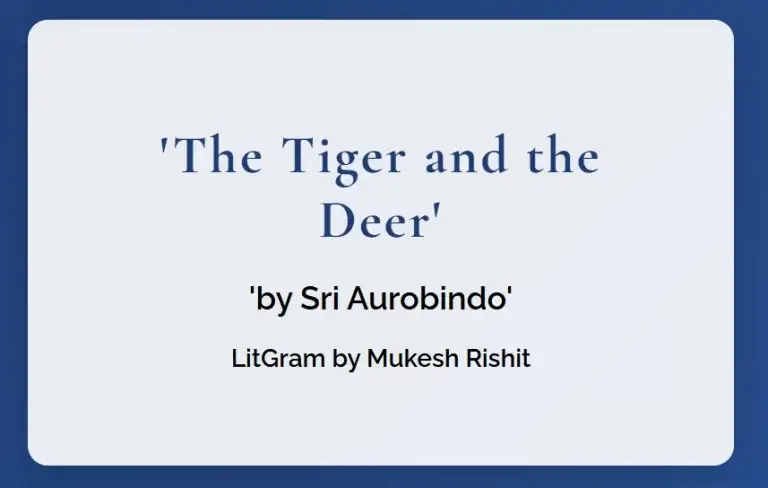Sri Aurobindo’s poem “The Tiger and the Deer” presents a powerful meditation on the contrasting forces of nature through vivid imagery and profound symbolism. This short but impactful work captures the brutal yet beautiful aspects of existence, offering readers a glimpse into the cyclical nature of life and death.
The Poem’s Genesis and Context
“The Tiger and the Deer” was published in 1930 during a significant period in Indian history. Sri Aurobindo, a versatile genius and intellectual giant, created this poem during his early lyrical phase, before his complete immersion in yogic and mystical practices .
The poem employs free quantitative verse, a technique that allows the rhythm to develop organically line by line rather than following rigid metrical patterns. This stylistic choice enhances the natural flow of the narrative while showcasing Aurobindo’s mastery of the English language .
Complete Text Analysis
The poem begins with a striking introduction to the tiger:
Brilliant, crouching, slouching, what crept through the green heart of the forest,
Gleaming eyes and mighty chest and soft soundless paws of grandeur and murder?
These opening lines establish the tiger as both magnificent and deadly. The words “brilliant,” “gleaming,” and “mighty” highlight its beauty and power, while “crouching,” “slouching,” and “murder” emphasize its predatory nature . The phrase “green heart of the forest” personifies the setting, making it feel alive and vulnerable .
The next lines introduce the atmosphere of tension:
The wind slipped through the leaves as if afraid lest its voice and the noise of its steps perturb the pitiless Splendour,
Hardly daring to breathe.
Even the wind, an element typically associated with freedom and power, moves cautiously through the forest, fearing to disturb the tiger. This personification of the wind heightens the sense of the tiger’s dominance .
The hunt unfolds with building tension:
But the great beast crouched and crept, and crept and crouched a last time, noiseless, fatal,
Till suddenly death leaped on the beautiful wild deer as it drank
Unsuspecting from the great pool in the forest’s coolness and shadow,
The repetition of “crouched and crept” creates a rhythmic quality that mirrors the tiger’s deliberate movements, building anticipation for the inevitable attack. The word “fatal” foreshadows the outcome, while the abrupt shift to “suddenly death leaped” captures the shocking violence of nature .
The deer is presented in stark contrast to the tiger:
And it fell and, torn, died remembering its mate left sole in the deep woodland, –
Destroyed, the mild harmless beauty by the strong cruel beauty in Nature.
The deer represents innocence and vulnerability. In its final moments, it thinks not of itself but of its mate left alone—a poignant detail that humanizes the creature and evokes sympathy . The juxtaposition of “mild harmless beauty” and “strong cruel beauty” encapsulates the poem’s central theme of opposing forces in nature .
The poem concludes with a prophetic vision:
But a day may yet come when the tiger crouches and leaps no more in the dangerous heart of the forest,
As the mammoth shakes no more the plains of Asia;
Still then shall the beautiful wild deer drink from the coolness of great pools in the leaves’ shadow.
The mighty perish in their might; The slain survive the slayer.
These final lines shift from present reality to future possibility. The reference to the extinct mammoth suggests that even the mightiest creatures eventually disappear, while gentler beings may endure. The last line—”The mighty perish in their might; The slain survive the slayer”—offers a profound reflection on the transient nature of power .
Key Themes and Symbolism
Duality in Nature
The central theme of “The Tiger and the Deer” is the coexistence of opposing forces in nature. The tiger embodies strength, power, and cruelty, while the deer represents gentleness, innocence, and vulnerability .
| Tiger | Deer |
|---|---|
| Strong | Mild |
| Cruel | Harmless |
| Predator | Prey |
| Death | Life |
| Darkness | Light |
| Arrogance | Humility |
This contrast isn’t presented as a simple moral judgment but as an observation of nature’s inherent duality. Both animals are described as beautiful, suggesting that both strength and gentleness have their place in the natural order .
Cycle of Life and Death
The poem vividly portrays the brutal reality of predator and prey, but it also hints at a larger cycle. The prophetic ending suggests that even the mightiest creatures eventually face extinction, while gentler beings may outlast them .
This cyclical view aligns with Hindu philosophical concepts familiar to Aurobindo, who later became deeply engaged with spiritual matters. The idea that “the mighty perish in their might” suggests karma—the notion that actions have consequences that unfold across time .
Political Allegory
Many interpreters see “The Tiger and the Deer” as a political allegory. Written during British colonial rule in India, the tiger might represent imperial power, while the deer symbolizes the colonized Indian people .
The prophecy that the tiger will one day “crouch and leap no more” parallels Aurobindo’s nationalist hope for Indian independence. Before dedicating himself to yoga and philosophy, Aurobindo was actively involved in the Indian independence movement, and this poem may reflect those political aspirations .
Stylistic Elements
Imagery and Sensory Details
Aurobindo’s mastery of imagery creates a vivid sensory experience:
- Visual imagery: “gleaming eyes,” “mighty chest,” “beautiful wild deer”
- Tactile imagery: “soft soundless paws”
- Environmental imagery: “green heart of the forest,” “coolness and shadow”
These details make the scene come alive, allowing readers to visualize the forest setting and the animals within it .
Sound and Rhythm
The poem’s rhythm mimics its content. The opening lines describing the tiger move with a measured pace, creating tension. The attack happens abruptly with a sudden shift in rhythm, and the concluding prophetic section adopts a more measured, contemplative tone .
Symbolism
Beyond the obvious symbolism of the tiger and deer, other elements carry symbolic weight:
- The forest represents the world or natural order
- The water pool symbolizes life and sustenance
- The wind personifies natural forces that recognize and defer to power
- The mammoth represents extinct power, suggesting that all dominance is temporary
Literary and Historical Context
Indo-Anglian Literature
Aurobindo stands as “the greatest figure of Indo-Anglian literature,” according to some critics . His work bridges Eastern philosophical traditions and Western literary forms, creating a unique fusion that helped establish Indian literature in English as a significant body of work.
“The Tiger and the Deer” demonstrates this fusion through its use of English poetic techniques while exploring themes central to Indian philosophical thought, such as the cyclical nature of existence and the transience of power .
Comparison with Other Nature Poets
Aurobindo’s approach to nature can be compared to other major poets:
- Like William Blake’s “The Tyger,” Aurobindo’s poem explores the beauty and terror inherent in nature
- Unlike the Romantic poets who often idealized nature, Aurobindo presents nature realistically, acknowledging its brutality
- Similar to T.S. Eliot in “The Waste Land,” Aurobindo finds order and meaning in apparent chaos
Philosophical Underpinnings
Spiritual Evolution
While “The Tiger and the Deer” predates Aurobindo’s deepest spiritual works, it hints at his evolving philosophy. The prophetic ending suggests transformation and progress—a concept central to his later spiritual thought about the evolution of consciousness .
The poem could be interpreted as symbolic of the transformation of souls, pointing toward “the divination of the entire earth” that Aurobindo later elaborated in his philosophical works .
Ethics and Nature
The poem raises ethical questions without offering simple answers. Is the tiger evil for killing the deer? Or is it simply following its nature? The poem presents both animals as beautiful in their own ways, suggesting a perspective beyond conventional moral judgments .
Critical Reception and Interpretation
Critics have praised “The Tiger and the Deer” for its vivid imagery and philosophical depth. Nirmalya Ghatak noted that “the entire poem is a vivid painting in words” where “all movements and even each footstep of the tiger are living to our eyes in the rhythmic expression” .
The poem has been interpreted variously as:
- A simple nature poem depicting predator and prey
- A political allegory about colonialism
- A metaphysical exploration of good and evil
- A commentary on the “modern craze for power and domination over the underdogs and the downtrodden”
Timeline of Sri Aurobindo’s Literary Development
| Period | Focus | Representative Works |
|---|---|---|
| Early Period (1890s-1908) | Political writing, early poetry | “The Tiger and the Deer” |
| Transitional Period (1908-1920) | Spiritual exploration, philosophical writing | “Thought the Paraclete” |
| Mature Period (1920-1950) | Mystical poetry, yoga philosophy | “Savitri,” “The Life Divine” |
The Poet: Sri Aurobindo Ghosh
Sri Aurobindo (1872-1950) was a multifaceted genius whose contributions spanned literature, philosophy, and political thought. Born in Calcutta and educated in England, he returned to India to become a leader in the independence movement before turning to spiritual pursuits .
As a poet, Aurobindo considered himself “first and foremost” a creator of verse, though his reputation now rests equally on his philosophical works. His poetry ranges from short lyrics like “The Tiger and the Deer” to epic works like “Savitri” .
The Poem’s Enduring Significance
“The Tiger and the Deer” continues to resonate with readers nearly a century after its publication. Its themes of power dynamics, the beauty and cruelty of nature, and the cyclical pattern of existence remain relevant to contemporary concerns about environmental conservation, political power, and ethical relationships .
The poem’s prophetic optimism—suggesting that gentleness may ultimately outlast brutality—offers hope in a world often dominated by conflict and power struggles. This message transcends its original context, speaking to universal human hopes for justice and harmony .
Interactive Quiz: Test Your Understanding of “The Tiger and the Deer”
- What does the tiger symbolize in the poem?
- A) Freedom
- B) Power and cruelty
- C) Wisdom
- D) Transformation
- What is the deer doing when the tiger attacks?
- A) Sleeping
- B) Running
- C) Drinking water
- D) Eating
- What does the deer think about as it dies?
- A) Its pain
- B) Its mate left alone
- C) Revenge
- D) Nothing
- What extinct animal does Aurobindo mention in the poem?
- A) Dinosaur
- B) Dodo
- C) Mammoth
- D) Saber-toothed tiger
- What poetic technique does Aurobindo use for this poem?
- A) Sonnet form
- B) Free quantitative verse
- C) Haiku
- D) Blank verse
Key Takeaways
“The Tiger and the Deer” demonstrates Aurobindo’s ability to pack profound meaning into a short lyrical form. The poem:
- Contrasts the “strong cruel beauty” of the tiger with the “mild harmless beauty” of the deer
- Uses vivid imagery to bring the forest scene to life
- Ends with a prophetic vision that power eventually fades while gentleness endures
- Functions on multiple levels: as nature poetry, political allegory, and philosophical meditation
- Showcases Aurobindo’s mastery of English verse while expressing Indian philosophical concepts
The poem remains a testament to Aurobindo’s belief that even small works can achieve greatness—that “in small proportions also we see just beauties and life becomes perfect in short measures too” .
Through its exploration of life’s harsh realities and its ultimate message of hope, “The Tiger and the Deer” continues to speak to readers seeking to understand the beautiful yet brutal world we inhabit.


